Servicios Personalizados
Articulo
Latin American applied research
versión impresa ISSN 0327-0793
Lat. Am. appl. res. v.32 n.3 Bahía Blanca jul./sept. 2002
Joining steels by means of an amorphous welding porcess
B. Arcondo+, F. Audebert, C. Epelbaum, M. Fontana and H. Sirkin
Laboratorio de Sólidos Amorfos, Facultad de Ingeniería, UBA. Paseo Colón 850 (1063) Buenos Aires, Argentina
+E-mail address: barcond@fi.uba.ar
Abstract — The Laboratorio de Sólidos Amorfos started research on amorphous bonding processes in 1998. Since the beginning of 2000 a three year project devoted to this subject "Joining metals by amorphous metals diffusion" has been subsidized by the ANPCyT(1) and Siderca. In this work the antecedents of the project are summarized, the welding method is described and the results obtained up to now are reported.
Keywords — amorphous bonding, welding, amorphous metals, steel.
I. INTRODUCTION
The Laboratorio de Sólidos Amorfos (LSA) was born as a consequence of the basic research on liquid semiconductors performed in the 70's in the Physics Department. In the early 80's a group devoted to the study of semiconducting glasses and amorphous metals produced by means of rapid solidification techniques (Quintana et al. 1979), and analyzed employing X-ray diffractometry and Mössbauer spectrometry consolidated as a new laboratory, the LSA. The early works were devoted to the glass forming ability of several binary and ternary chalcogenide based systems (Quintana et al. 1982, Arcondo et al. 1984, Arcondo et al. 1985 ab, Fontana et al. 1992). By the end of this period, the glass forming mechanisms of a collection of Mg based alloy were studied. These alloys are MgSnX (X= Cu, Ni, Zn and Ga) and MgZnPb (Mingolo et al. 1986, Sirkin et al. 1987, Mingolo et al. 1989, Vicente et al. 1991, Arcondo et al. 1991a, Vicente et al. 1992, Fontana and Arcondo, 1994, Fontana and Arcondo, 1995, Somoza et al. 1995).
Once the rapid solidification melt spinning technique was implemented in the Laboratorio de Sólidos Amorfos, work on Fe or Ni based multicomponent systems began. Among them FeB, NiB, FeNiB, FeBSn, NiBSn, FeNiBSn (Boudard et al. 1991, Arcondo et al. 1991b, Arcondo et al. 1994 a-d)
After this, a new stage started, characterized by the diversification of the properties studied and the opening to the collaboration with European research groups. Two main lines, metallic and chalcogenide glasses, have been developed. The amorphous metals line, included as well the study of nanostructured alloys obtained by means of a controlled crystallization process of FeSiB (Moya et al, 1997a) and several light amorphous metals (Audebert et al. 1997a). The glass forming ability, the structure (Audebert et al. 1997b), the mechanical (Moya et al. 1997b) (Young´s modulus, microhardness, tensile strenght, plasticity and fracture) and magnetic (coercivity, saturation, remanence and permeability) (Moya et al. 1999) properties, the corrosion resistance (Audebert et al. 1998), in acid and basic media, and the crystallization processes have been analyzed. The systems studied were FeSiBSn, FeSiBNb, FeSiBNbSn, Fe- SiBNbCu, FeSiBNbCuX (X= Al, Cr, Ag, C, etc.), Al- FeX (X=Nb, Sb, MM: Mishmetal, a Rare Earths mixture) and Mg(Cu, Al)MM. The chalcogenide glasses line main interests have been the structure and electric and mass transport studies and the crystallization kinetics (Fontana et al. 2000a, Fontana et al. 2000b).
In the early 90's a new project tending to the development of a centrifugal atomization device to produce metallic powders with the aim to obtain sintered pieces of high mechanical resistance was initiated. The systems studied were CoCrWC and FeMnAlSiC (Ozols et al. 1999, Ozols et al. 1996). This line is oriented nowadays towards the elaboration of soft magnetic nucleus employing preisolated powder particles. The systems under study are NiFeMo, FeCoV and NiFeCo.
The results of these works are reported in more than 100 papers in international journals and the contribution of the Laboratorio de Sólidos Amorfos to the formation of human resources has been expressed in 10 doctoral thesis in Physics and Engineering.
The above mentioned lines are supplemented at the present time with a technological project oriented to the development of metallic joints employing amorphous metals layers and a recently initiated project oriented to the modification of metallic or semiconducting surfaces employing laser discharges.
II. METHODS
A. Amorphous Welding Method
Let us assume that two bars of a metal α are aligned with their slightly polished butts in contact with a thin amorphous layer L (Fig. 1). The composition of L is not far from an eutectic point which components are α and β (Fig. 2). The melting temperature of L (TL) is lower than the melting temperature of α (Tα). If the temperature in the joining zone is raised to Tj at the higher attainable rate, being TL<Tj<Tα, a transient liquid phase gap, with an initial composition xL, is originated. As the temperature Tj is maintained constant the following process will take place: i) the dissolution of the α atoms from the bars into the liquid gap takes place, widening the gap ii) when the liquid composition xM is attained, the solidification starts and the thinning of the gap proceeds up to its total disappearance, iii) the completion of the solid state diffusion is performed (Cain et al. 1997, Tuah-Poku et al. 1988) (Fig. 3). Moreover, if the diffusion coefficient of β in α is large, the picture must include the simultaneous diffusion of β into the bars with the consequent shortening of the process.
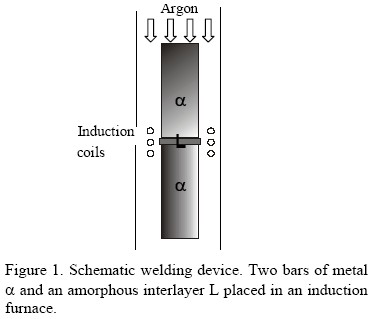
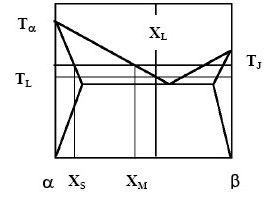
Figure 2. Phases equilibrium diagram of the α-β system.
TJ is the isothermal welding temperature, XL the initial
composition of the transient liquid gap, XM the
composition of the liquid gap as a solid phase of composition
XS precipitates.
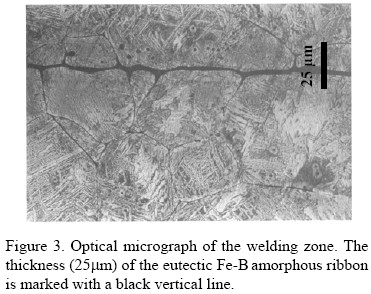
In the case that α bars are single crystalline, a planar diffusion front can be modeled but being the bars polycrystalline the diffusion along grain boundaries has to be analyzed (Kaur et al. 1995). The amorphous nature of the layer is not a precondition for the transient liquid phase bonding process but, due to its large toughness (when compared with the corresponding crystalline state), small thickness amorphous layers are easy to handle and the contact between the layer and the bars is improved, particularly when pressure is applied.
B. Experimental Procedure
Fe rich Fe-B and Fe-Si-B amorphous metals have been employed as interlayers in transient liquid phase bonding processes performed to join two Carbon Manganese steel bars α* with Fe the majority component α. The bars were aligned with the polished butts of both pieces in contact with the amorphous layer and located into the coil of four turns in an induction furnace under Ar flux. The heated area is a fringe of 10 mm to both sides of the line of joint. The temperature has been raised at the highest attainable rate to T≈1300°C and then maintained constant. The welding processes modelling must include a) layer thickness of about 25µm with melting temperatures T≈ 1100°C , b) the dissolution of the Fe, and other species atoms, from the bars into the liquid gap while the B atoms migrate from the liquid towards the bars with a grain boundaries diffusion coefficient much higher than the bulk diffusion constant, despite the grain boundary segregation effects on B diffusivity.
III. RESULTS
Bonds performed employing Fe-B amorphous ribbons are depicted in Figs. 3-5. Figure 3 shows an optical micrography of the welding zone. The vertical black line represents the thickness (25 µm) of the amorphous Fe-B interlayer. The remaining welding traces denote an incomplete diffusion as well as the rol of the grain boundaries in the process. The microstructure of the welding zone is a consequence of both the boron diffusion and the termal process.
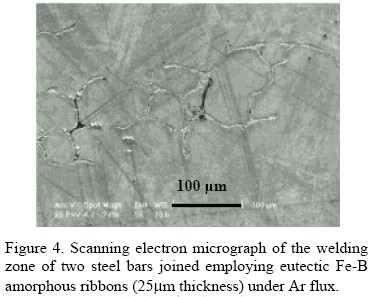
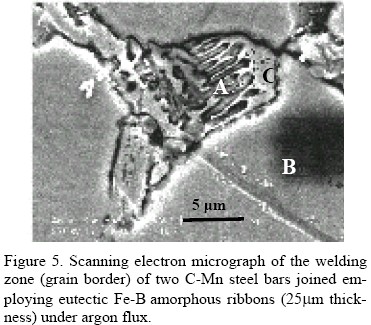
Figures 4 and 5 correspond to scanning electron micrographs of Carbon Manganese steel bars welded employing eutectic Fe-B amorphous ribbons with a 25µm thickness. The thermal process does not differ significantly from the above mentioned. Boron has been detected by EDAX in all the positions marked as A, B and C denoting inter grain as well as intra grain diffusion.
Average Vickers microhardness has been measured applying 200g loads during 15 seconds in several points in the whole width of the bars. A significative increasing of the Vickers microhardness has been observed in the joint zone, as compared with that of the C-Mn steel bars (about 260 Hv) (Figure 6a). This fact is a consequence of the formation of martensite and, probably, borides. The first one is formed by means of a cooling in air due to the solid solubility of boron. Borides, although their presence could no be confirmed by X Ray diffraction, are not discarded in the grain boundaries as a consequence of the high boron content of the amorphous ribbons (17 at. % B). An incomplete diffusion of boron due to the presence of borides in the grain boundaries may induce the snappy variations of the microhardness observed along the affected zone.
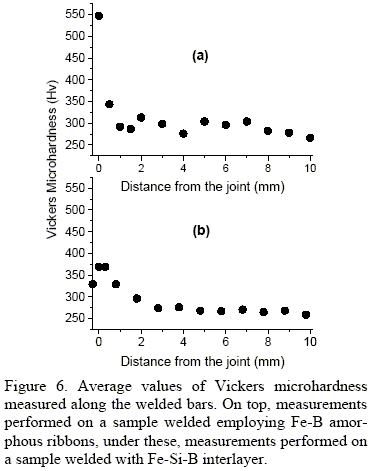
Fe-Si-B amorphous ribbons (25µm thick and 5mm wide) have been obtained with the aim to improve the mechanical properties of the joints. In fact, Vickers microhardness of the welding zone decreases as can be seen in Figure 6b. Also, smooth variations of the microhardness can be observed denoting a more complete diffusion as the boron content is significantly lower. This fact would ensure a reduction in the process duration as later annealings will not be necessary.
After the welding process, the samples were annealed to transform the martensite and to complete the solid state diffusion.
Figures 7 and 8 depict the welding zone and the thermally affected region, 3mm above the joint, of samples welded employing Fe-Si-B amorphous ribbons.
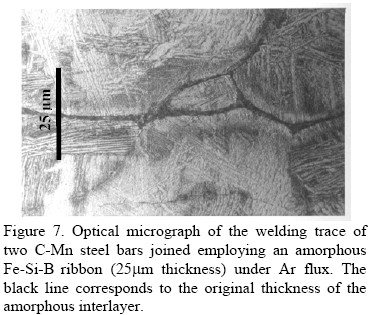
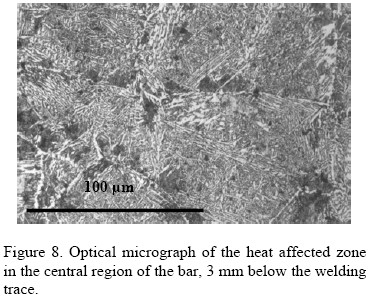
The extension of the thermally affected zone depends on several variables, the temperature of the process, its duration and the height of the heating coils. In the case of the sample depicted in Fig. 7 and 8, four coils were employed.
IV. CONCLUSIONS
In view of the results presented here, this TLP bonding method employing amorphous interlayers is a suitable method for welding steel pieces of different geometries i.e. bars or pipes.
The duration of the process is in the order of a few minutes, the temperature is not much higher than the melting point of the interlayer. No high pressures are involved. Nevertheless the significant parameters must be optimized in order to improve the mechanical properties of the joint and also its corrosion resistance. An aspect that has not been explored yet in this project
ACKNOWLEDGEMENTS
The authors acknowledge Mr. A. Carnero, Mr. E. Carretero and Eng. E. Castro their collaboration in the technical aspects of this work.
Also, the financial support of the Universidad de Buenos Aires, the Agencia Nacional para la Promoción de la Ciencia y la Tecnología and Siderca, through the PICTO 4603, is greatly acknowledged.
NOTES
1. Agencia Nacional para Promoción de la Ciencia y la Tecnología.
REFERENCES
1. Arcondo, B., Quintana, G., Sirkin, H. and Cernuschi, F.,"Mössbauer Study in (In15Te85)xSn(1-x) Obtained by Splat Cooling", Journal of Non-Crystalline Solids, 65, 435-438 (1984).
2. Arcondo, B., Quintana, G. and Sirkin, H., "Mössbauer and x Ray Diffraction Studies in (In16Te84)1-xSnx and (Ge85Te15)1-xSnx Amorphous Alloys", Anais do Simpsio Latinoamericano de Física dos Sistemas Amorfos, Vol.2, Publicaçao do Centro Latinoamericano de Física, Rio de Janeiro, Brasil, 434- 437 (1985 a).
3. Arcondo, B., Quintana, G. and Sirkin, H.; "Glass Forming Ability of GeTeSn with Tin Concentration and Initial Conditions", Z. für Metallkunde, 40a, 544-547 (1985 b).
4. Arcondo, B., Boudard, M. and Sirkin, H., "Mössbauer studies on NiBSn amorphous system", Hyperfine Interactions, 66-7 (1-4) 677-680 (1991 a).
5. Arcondo, B., Manzanelli, R., Audebert, F. and Sirkin, H., "Contribution to the study of the MgNiSn system", Hyperfine Interactions, 66-7 (1-4) 359-364 (1991 b).
6. Arcondo, B., Lorenzo, A., Audebert, F. and Sirkin, H.,"Glass Forming Tendency in the FeBSn System", Hyperfine Interactions, 83(1-4) 281-8 (1994 a).
7. Arcondo, B., Moya, J., Audebert, F. and Sirkin, H.,"Structural Relaxation on FeNiB Amorphous Alloy", Hyperfine Interactions, 83 (1-4) 293-297 (1994 b).
8. Arcondo, B., Audebert, F., Lorenzo, A. and Sirkin, H.,"Short Range Order in the FeBSn Amorphous System", Hyperfine Interactions, 94 (1-4) 2145- 2150 (1994 c).
9. Arcondo, B., Moya, J., Audebert, F. and Sirkin, H.,"Mössbauer Studies on FeNiB Amorphous System", Hyperfine Interactions, 94 (1-4) 2157-2161 (1994 d).
10. Audebert, F., García Escorial, A. and Sirkin, H. , "Aluminin- rich Al-Fe-Nb Amorphous and Nanocrystalline Alloys", Scripta Materialia, 36 (4), 405-410 (1997 a).
11. Audebert, F., Sirkin, H. and García Escorial, A., "Approach to the atomic structure of melt spun Al-Fe- Nb alloys"; Philosophical Magazine. B, 76-4, 483- 487 (1997 b).
12. Audebert, F., Vazquez, S.M., Gutierrez, A., Vergara, I., Alvarez, G., García Escorial, A. and Sirkin, H.,"Mechanical and Corrosion Behaviour of Al-Fe-Nb Amorphous Alloys", Materials Science Forum Vol. 269-272, 837-842 (1998).
13. Boudard, M., Arcondo, B. and Sirkin, H., "Glass forming ability of the NiBSn system", Journal of Materials Science, 26, 6517-6521 (1991).
14. Cain, S.R., Wilcox, J.R. and Venkatraman, R., "A Diffusional Model for Transient Liquid Phase Bonding", Acta Materialia 45, 2, 701-707 (1997).
15. Fontana, M., Bozzano, P., Lallée, S. and Arcondo, B.,"Atomic and Electronic Structure of the Pseudobinary System SnxPb(1-x)Te", Journal of Physics and Chemistry of Solids, 53-8, 1101-1103 (1992).
16. Fontana, M. and Arcondo, B., "Non-Equilibrium and Crystalline Phases on the Mg-Ga-Sn System", Hyperfine Interactions, 83 (1-4) 245-52 (1994).
17. Fontana, M. and Arcondo, B., "Crystallization Process on Amorphous Mg-Ga-Sn System", J. of Materials Science, 30, 734-736 (1995).
18. Fontana, M., Arcondo, B., Clavaguera-Mora, M.T., and Clavaguera, N., "Crystallisation kinetics driven by two simultaneous modes of crystal growth", Philosophical Magazine B, 80, 10, 1833-1856 (2000).
19. Fontana, M., Arcondo, B., Clavaguera-Mora, M.T., Clavaguera, N. and Greneche, J.M., "Crystallisation Kinetics and Structural Aspects of TeGaSn Amorphous Alloys"; J. Appl. Physics, 88, 6, 3276- 3284 (2000).
20. Kaur, I., Mishin, Y., Gust, W., "Fundamentals of Grain and Interfase Boundary diffusion" (John Wiley and Sons LTD, New York, 1995).
21. Mingolo, N., Arcondo, B., Nassif, E. and Sirkin, H.,"Changes in the Glass Forming Ability of MgZnSn Due to the Presence of an Intermetallic Compound", Z. für Metallkunde, 41a, 1357-1360 (1986).
22. Mingolo, N., Nassif, E., Arcondo, B and Sirkin, H.,"Two Competitive Effects in the Glass Forming Ability of Mg-Based Binary Alloys", Journal of Non-Crystalline Solids 113, 161-166 (1989).
23. Moya, J., Vázquez, M., Cremaschi, V., Arcondo, B. and Sirkin, H., "Mössbauer Spectroscopy and Young's Modulus Measurements in the Study of the Crystallization Processes of Several FeSiB Based Glasses", Hyperfine Interactions C, 2, 89-92 (1997 a).
24. Moya, J., Vazquez, M., Cremaschi, V., Arcondo, B. and Sirkin, H., "Structural, Mechanical and Magnetic Properties in Heat Treated Fe73.5Si22.5- xBxNb3Cu1 (6 < x < 12) Alloy Ribbons", NanoStructured Materials, Vol. B, No 5, 611-621 (1997 b).
25. Moya, J., Arcondo, B., Sirkin, H., Sartorelli, M.L., Knobel, M., Vazquez, M., "GMI of Al-substituted Fe-Si-B-Cu-Nb nanocrystalline ribbons", J. Magn. Mag. Mat. 203, 117-119 (1999).
26. Ozols, A., Sirkin, H.R. and Vicente, E.E.. "Segregation in Stellite Powders Produced by Plasma Rotaiting Electrode Process". Materials Science and Eng. A262, 64-69 (1999).
27. Ozols, A., Bonetto, R. and Sirkin, H., "Microestructura de Aleaciones Base Co-Cr Obtenidas Mediante Atomización Centrífuga por Descarga de Plasma", Información Tecnológica, Vol. 7, Nro. 6, 79-82 (1996).
28. Quintana, G., Sirkin, H., Rosen, M., Kurlat, D. and Frank, E., "A Simple Splat Cooling Equipment", Revista Brasileira de Física, Vol.9, N 1 (1979).
29. Quintana, G., Sirkin, H. and Arcondo, B., "Mössbauer Effect in Splat Cooled SnTe Alloys", Proceedings of the International Conference on the Applications of the Mössbauer Effect, Indian National Science Academy, New Delhi, India, 536-538 (1982).
30. Sirkin, H., Mingolo, N., Nassif, E. and Arcondo, B.,"Increase in the Glass Forming Compostion Range of Mg-Based Binary Alloys by Addition of Tin", Journal of Non-Crystalline Solids, 93 (2-3), 323- 330 (1987).
31. Somoza, J.A., Gallego, L.J., Rey, C., Rozenberg, S., Arcondo, B., Sirkin, H., Tendler, R.H., Kovacs, J.A., Alonso, J.A., "An Experimental and Theoretical Study of the Glass Forming Region of the Mg- Cu-Sn System", Journal of Materials Science, 30, 40-46 (1995).
32. Tuah-Poku, I., Dollar, M. and Massalski T.B., "A Study of the Transient Liquid Phase Bonding Process applied to a Ag/Cu/Ag Sandwich Joint", Metallurgical Transactions A, 19A, 675-686 (1988).
33. Vicente, E., Bermudez, S., Esteban, A., Arcondo, B., Sirkin, H. and Tendler, R., "Invariant three and Four-Phase Equilibria in the Mg-Rich Corner of the MgCuSn Ternary System", Journal of Materials Science, 26, 5, 1327-1332 (1991).
34. Vicente, E., Bermudez, S., Tendler, R., Arcondo, B. and Sirkin, H., "The Mg-Mg2Cu-Mg2Sn Ternary Eutectic", J. Mater. Sci. Letters, 11, 523-524 (1992).
Received: May 15, 2000.
Accepted for publication: Febrary 15, 2002.
Recommended by Subject Editor E. Dvorkin.












